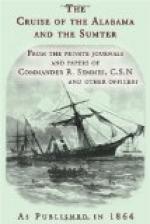Two days more and another actor appeared upon the scene. Like her colleague at Tangier, the United States frigate Tuscarora had got scent of a valuable prey, and hurried round to the Mersey at full speed of sail and steam to secure it. But by the time she arrived at Moelfra Bay, the “No. 290” was already a couple of days upon her outward voyage. The game was up, and the only resource of the baffled Yankee now lay in scolding poor Earl Russell, who certainly had been no willing agent in the escape of the daring little Confederate cruiser.
CHAPTER XIII.
"No. 290” at sea—The rendezvous—Small mishaps—Good qualities of the new ship—Nearly discovered—The captain—Terceira—Anxiety about the crew—Coaling and arming—Getting to rights—Ready for the cruise.
“No. 290” ran rapidly before the S.W. gale up the Irish Channel, and past the Isle of Man and Ailsa Crag, till as the columns of the Giant’s Causeway began to loom dimly through the driving rain she rounded to, laid her maintopsail to the mast, and sent a boat on shore with the pilot and Captain Bullock, who up to this time had been in command of the vessel. She was now transferred to the charge of Captain J. Butcher, late of the Cunard service, her other temporary officers being—Chief Lieutenant, J. Law, of Savannah, Georgia; second, Mr. G. Townley Fullam, of Hull, England; Surgeon, D.H. Llewellyn, of Easton, Wilts; Paymaster, C.R. Yonge, of Savannah, Georgia; and Chief Engineer, J. McNair, an Englishman. The crew, the greater number of whom had been taken on board in Moelfra Bay, numbered about seventy men and boys, and were shipped for a feigned voyage, the Confederate captain trusting to the English love of adventure, to induce them to re-ship when the true destination of the vessel came to be declared.
Bidding adieu to the Irish coast she now shaped her course for Terceira, one of the Western Islands, where she was to meet her consort, and receive on board the guns and other warlike stores, she had been restrained by respect for English law, from shipping in Liverpool. Throughout this run, which occupied nine days, the wind still continued blowing a strong gale from the southward and westward, with a heavy sea running, through which “No. 290” dashed along sometimes at a speed of upwards of thirteen knots an hour. It was not, however, without a certain amount of risk that this pace was maintained. Amongst other less serious damages the bow port was stove in by a heavy sea, and altogether the vessel showed manifest symptoms of the speed at which she had been driven. But accidents of this kind were of minor importance compared with the supreme value of time. Once fairly off, and the news of the escape must spread rapidly through the kingdom. The first whisper of it would bring the enemy’s ships in pursuit, and a single hour’s delay in reaching her destination and placing herself in a condition for self-defence, might bring one of them alongside, and the career of the new cruiser be cut short before it had fairly begun. So “No. 290” “crashed on” at top speed, and on the 10th of August “Land, ho!” was called from the foremasthead, and she brought up at Porto Praya in Terceira.




